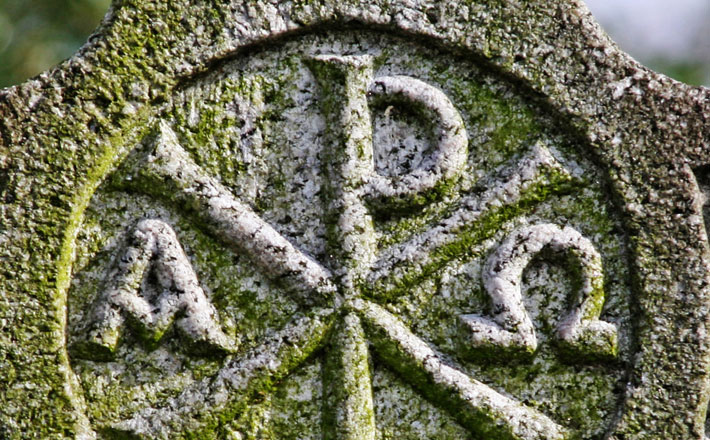Commentary on John 17:20-26
On his last night with the disciples, Jesus shares a meal with them, washes their feet, gives them a new commandment, and answers question after question concerning the fact that he is about to leave them (John 13-16).
After all that, Jesus begins to pray.
In Matthew, Mark, and Luke, when Jesus prays before his arrest, he is in Gethsemane, and he prays alone. Even his most trusted disciples are some distance from him, and rather than listening, praying, or keeping watch, they fall asleep (cf. Mark 14:32-42 and parallels).
In the gospel of John, the scene is different. Jesus and the disciples have not yet traveled to the garden where Jesus will be met by Judas and betrayed. In John, when Jesus prays, the disciples are within earshot. Throughout the earlier part of the evening Jesus had given them as much information as he could about what was about to happen and how he would provide for them in the future. Now Jesus turns from offering information to them and begins to offer intercession for them.
This turn in the farewell discourse (John 13-17) from information to intercession is the first point to keep in mind as one prepares to preach any text from John 17. In this chapter, Jesus is not offering instructions to the disciples or to the church they will lead. This means, for instance, that as important as evangelism is, when Jesus tells his Father that he is asking “not only on behalf of these, but also on behalf of those who will believe in me through their word” (John 17:20), he is not exhorting the church to participate in evangelism. Likewise, as commendable as ecumenical partnerships are, when Jesus asks that those who believe and those who do not yet believe “may be one” (John 17:21), he is not exhorting involvement in ecumenical dialogue. Jesus is not exhorting the church here. He is not instructing. He is not preaching, teaching, or rallying the troops. Jesus is praying.
How do you feel when someone prays out loud for you? When I asked a few friends this question, these words surfaced: comforted, vulnerable, grateful, honored, humbled, awkward but appreciative, like someone really cares. Maybe one of the reasons it is so easy to turn John 17 into a “to do” list for the church is that such a list is easier to manage than such an experience as intimate as being the subject of another’s prayer. We are so obviously not in control as we listen to people pray for us. They, not we, are the ones doing the asking, and God, not we, is the one answering the prayer. If Jesus were exhorting his disciples, and by extension us, we could strive to meet his expectations then. If he were exhorting us, we would have a mission, namely, not to disappoint him. Instead, we overhear a prayer on our behalf and are not called to action in that moment as much as wonder that the Father and the Son spend their time discussing the likes of us and our little community of faith.
And there is more. There is more to wonder at than the fact that followers of Jesus are a topic for discussion among members of the Trinity. The content of the prayer is equally humbling and honoring. At the center of the prayer in John 17 is the relationship that the first and second members of the Trinity share and the work of the Son, as a result of the Father’s sending (verse 8), to draw everyone into that relationship.1 The Son is “close to the Father’s heart” (John 1:18), or as the KJV puts it, “in the bosom of the Father.”
Throughout his ministry, Jesus has made known that One whom he knows so well. Now, Jesus prays, “As you Father are in me and I am in you, may they also be in us…” (John 17:21). Jesus prays that those who follow him may be drawn into the life of the Holy Trinity. The Father sends the Son to humanity precisely so that the Son may draw all humanity into the relationship that exists between Father, Son, and Holy Spirit.
If being “drawn into the life of the Trinity” sounds a little esoteric for a Sunday morning, other texts in the gospel can help to say in other ways what Jesus is asking for on our behalf. At the center of John’s prologue is the news that, “to those who received him, who believed in his name, he gave power to become children of God” (John 1:12, NRSV, emphasis mine). When the risen Jesus meets Mary Magdalene near what had been his tomb, he commissions her, “Go to my brothers and say to them, ‘I am ascending to my Father and your Father, to my God and your God.'” My Father and your Father…. In the resurrection, the relationship that the Son and Father have always shared now extends to those for whom he prayed before his death.
Our own wonder at this prayer extends once more as its horizon widens. As the cozy communion of the three members of the Godhead is not an end in itself, neither is the cozy, if somewhat expanded, communion of the three members of the Godhead with all of Jesus’ brothers and sisters an end in itself. John 17:1 notes that Jesus looks up to heaven as he begins to pray. The outwardly-focused posture of Jesus offers a physical sign of the reach of his prayer.
In the gospel of John, “the world” is often a way of describing those who oppose Jesus. Nonetheless, it was for love of the world that God sent the Son (cf. John 3:16), and in this prayer, at the close of his ministry, Jesus intercedes not only for his own but also for that world. Jesus asks for unity and love between those given to him and the Father, “so that the world may believe that you have sent me” (John 17:21). Nothing less than the reconciliation of all things is in view. The telos–the goal–of the prayer is that even those who had been hostile to the coming of the Son (a.k.a. “the world”) may believe that the Father sent him. Such believing, we know, leads to life in his name (cf. John 20:31).
1As with other texts in John, finding appropriate and inclusive language for God in a sermon on this text is difficult. It does not work perfectly to call the Father, “God,” and the Son, “Jesus,” because such language may imply that Jesus is not also “God the Son.” On the other hand, the repetition of “Father” and “Son” too many times in the sermon reinforces an inaccurate understanding of God as male and of divinity as masculine. The point of the language is not the mistaken idea of the maleness of God. It is the reality that the way to speak accurately of God is to speak terms that describe the intimate, loving relationship that Jesus puts into words when he calls God father and refers to himself as God’s son.


May 16, 2010